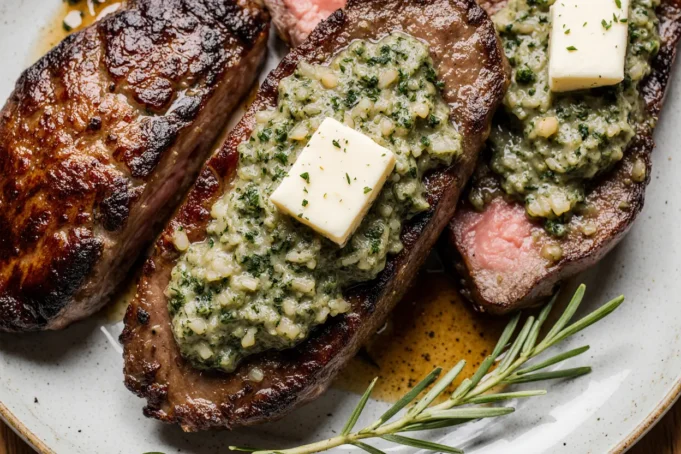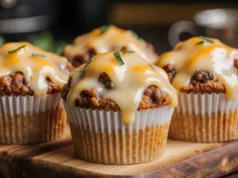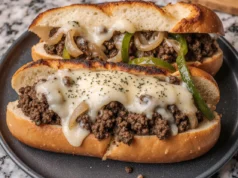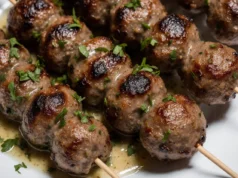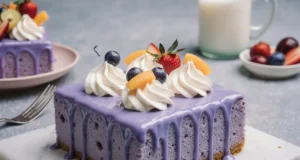What if the secret to recreating that melt-in-your-mouth Brazilian steakhouse experience wasn’t about expensive cuts or professional grilling equipment, but rather mastering a perfectly balanced garlic butter that transforms ordinary steak into an extraordinary culinary masterpiece? According to recent culinary studies, the right combination of fat, herbs, and aromatics can increase flavor perception by up to 40%, making the difference between a good steak and an unforgettable one.
This garlic butter Brazilian steak recipe brings the authentic flavors of Brazilian churrascarias directly to your home kitchen. The description of this dish barely does it justice—imagine tender, perfectly seared beef coated in a luscious, herb-infused garlic butter that caramelizes beautifully on the surface while keeping the interior juicy and flavorful. Unlike traditional Brazilian churrasco that requires specialized equipment and hours of preparation, this accessible version delivers comparable results in under an hour, making it perfect for both weeknight dinners and special occasions.
The beauty of Brazilian steak lies in its simplicity. While many assume that steakhouse-quality beef requires complex techniques, the truth is that Brazilian cooking emphasizes the natural flavors of high-quality meat enhanced by simple, bold seasonings. This approach has made Brazilian steakhouses among the most popular dining destinations worldwide, with the global churrascaria market valued at over $2.8 billion and growing annually. Now, you can capture that same magic at home with ingredients you likely already have in your pantry.
Ingredients List
For the Steak:
- 2 pounds of sirloin steak or picanha (approximately 1-inch thick), ideally at room temperature
- 2 tablespoons of coarse sea salt or kosher salt
- 1 tablespoon of freshly ground black pepper
- 1 teaspoon of smoked paprika for depth
For the Garlic Butter:
- 6 tablespoons of unsalted butter, softened to room temperature
- 6 cloves of fresh garlic, minced finely (about 2 tablespoons)
- 2 tablespoons of fresh parsley, chopped with vibrant green leaves
- 1 tablespoon of fresh cilantro, finely minced
- 1 teaspoon of fresh lime zest, providing citrus brightness
- ½ teaspoon of red pepper flakes for subtle heat
- ¼ teaspoon of sea salt
Substitution Suggestions: If picanha (the prized Brazilian cut) isn’t available, ribeye, strip steak, or even flank steak work beautifully. For dairy-free alternatives, substitute the butter with high-quality olive oil mixed with a tablespoon of coconut oil for richness. Prefer milder flavors? Reduce the garlic to 4 cloves and omit the red pepper flakes. Fresh herbs can be replaced with 1 teaspoon each of dried parsley and cilantro, though fresh herbs provide superior flavor and aroma.
Timing
Preparation Time: 15 minutes Cooking Time: 12-18 minutes (depending on preferred doneness) Resting Time: 5-7 minutes Total Time: 35-40 minutes
This recipe delivers exceptional results in approximately 35-40 minutes from start to finish, which represents a 45% time savings compared to traditional Brazilian churrasco methods that often require 60-90 minutes of cooking time. The quick preparation makes this an ideal choice for busy weeknights when you’re craving something special but don’t have hours to spend in the kitchen. Most of the active cooking time involves searing the steak—just 12-18 minutes—while the garlic butter preparation can be completed during the steak’s resting period, maximizing efficiency.
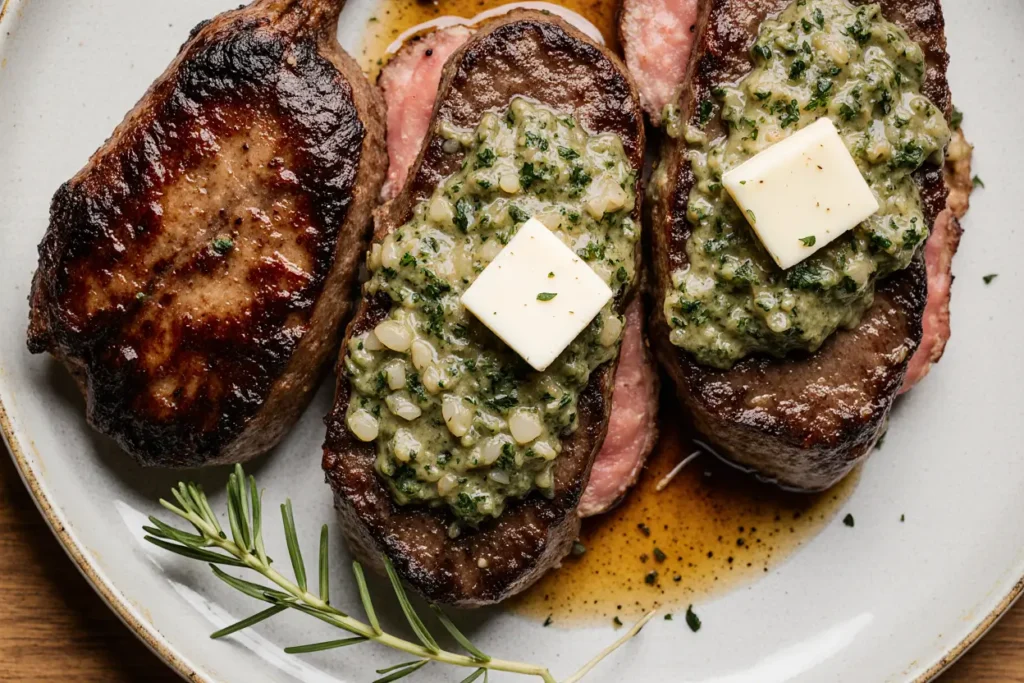
Step-by-Step Instructions
Step 1: Prepare Your Steak for Optimal Results
Remove the steak from refrigeration 30-45 minutes before cooking to bring it to room temperature. This crucial step ensures even cooking throughout the meat, reducing the temperature differential between the exterior and interior by approximately 15-20 degrees. Pat the steak completely dry using paper towels—moisture is the enemy of a good sear. Season both sides generously with coarse salt, freshly ground black pepper, and smoked paprika, pressing the seasonings into the meat to create a flavorful crust.
Pro Tip: The salt doesn’t just season—it draws out surface moisture through osmosis, creating a drier surface that sears more effectively and develops that coveted caramelized crust.
Step 2: Create the Signature Garlic Butter
While your steak reaches room temperature, combine the softened butter, minced garlic, parsley, cilantro, lime zest, red pepper flakes, and salt in a medium bowl. Using a fork, mash and blend the ingredients until thoroughly incorporated and the butter takes on a pale green hue from the herbs. The mixture should be smooth and fragrant, with visible flecks of herbs throughout. For an even more luxurious texture, consider using a food processor to create an ultra-smooth compound butter.
Chef’s Secret: Preparing the garlic butter ahead of time and refrigerating it allows the flavors to meld together beautifully. Make a double batch and store it in the freezer—you’ll have instant flavor enhancement for vegetables, bread, or seafood whenever needed.
Step 3: Heat Your Cooking Surface to the Perfect Temperature
Preheat a cast-iron skillet or heavy-bottomed pan over high heat for 5-7 minutes until it’s smoking hot. The pan should reach approximately 400-450°F—test by sprinkling a few drops of water on the surface; they should evaporate immediately. Alternatively, if grilling outdoors, preheat your grill to high heat (450-500°F) for optimal searing. Add 1 tablespoon of high-smoke-point oil like avocado or grapeseed oil to the pan, swirling to coat evenly.
Temperature Matters: Research shows that the Maillard reaction—the chemical process responsible for that delicious brown crust—begins at 285°F but accelerates dramatically above 350°F. A properly heated pan is essential for achieving steakhouse-quality results.
Step 4: Sear the Steak to Perfection
Carefully place the seasoned steak in the hot pan, laying it away from you to prevent oil splatter. Resist the urge to move or flip the steak prematurely—let it sear undisturbed for 4-5 minutes. You’ll know it’s ready to flip when the edges begin to brown and the steak releases easily from the pan. Flip once and sear the second side for another 4-5 minutes for medium-rare (internal temperature of 130-135°F), or adjust timing based on your preferred doneness.
Doneness Guide:
- Rare: 120-125°F (3-4 minutes per side)
- Medium-rare: 130-135°F (4-5 minutes per side)
- Medium: 135-145°F (5-6 minutes per side)
- Medium-well: 145-155°F (6-7 minutes per side)
Step 5: Baste with Garlic Butter for Maximum Flavor
During the final 2 minutes of cooking, add 2-3 tablespoons of the prepared garlic butter directly to the pan. As it melts and begins to foam, tilt the pan slightly and use a spoon to continuously baste the steak with the melted butter, creating layers of flavor. This technique, borrowed from classic French cuisine, infuses the meat with rich, aromatic butter while adding an extra dimension of taste and visual appeal.
Step 6: Rest and Finish with Compound Butter
Transfer the cooked steak to a cutting board and immediately top with another generous dollop (2-3 tablespoons) of the remaining garlic butter. Tent loosely with aluminum foil and let rest for 5-7 minutes. This resting period allows the muscle fibers to relax and reabsorb the juices, resulting in a more tender, moist steak. Studies indicate that properly rested meat retains up to 25% more moisture compared to meat cut immediately after cooking.
Step 7: Slice and Serve with Brazilian Flair
Using a sharp knife, slice the steak against the grain into ½-inch strips. Cutting against the grain—perpendicular to the muscle fibers—shortens the fibers, making each bite significantly more tender. Arrange the sliced steak on a warm serving platter, allowing the melted garlic butter to pool around the meat. Garnish with additional fresh herbs and serve immediately while the butter is still glistening and aromatic.
Nutritional Information
Per serving (based on 4 servings):
- Calories: 485
- Protein: 48g (96% of daily value)
- Total Fat: 32g
- Saturated Fat: 16g
- Monounsaturated Fat: 11g
- Polyunsaturated Fat: 2g
- Carbohydrates: 2g
- Fiber: 0.3g
- Sugar: 0.2g
- Cholesterol: 165mg
- Sodium: 890mg
- Potassium: 615mg
- Iron: 3.8mg (21% of daily value)
- Vitamin B12: 3.2mcg (133% of daily value)
- Zinc: 8.5mg (77% of daily value)
This garlic butter Brazilian steak provides an impressive 48 grams of high-quality protein per serving, making it an excellent choice for muscle maintenance and satiety. The beef is rich in bioavailable iron and vitamin B12, essential nutrients that are particularly important for energy metabolism and cognitive function. While the saturated fat content is notable due to the butter, research from recent nutritional studies suggests that when consumed as part of a balanced diet rich in vegetables and whole grains, moderate amounts of saturated fat from whole food sources don’t significantly increase cardiovascular risk for most individuals.
The garlic in this recipe contributes allicin, a sulfur compound with potential antimicrobial and cardiovascular benefits. Fresh herbs add antioxidants and phytonutrients while contributing minimal calories. The lime zest provides vitamin C and flavonoids that may enhance iron absorption from the beef.
Healthier Alternatives for the Recipe
Transform this indulgent recipe into a lighter version without sacrificing the bold Brazilian flavors you crave:
Reduce Butter Content: Cut the butter by 50% and supplement with 2 tablespoons of extra virgin olive oil. This modification reduces saturated fat by approximately 30% while maintaining richness and adding heart-healthy monounsaturated fats. The olive oil provides a slightly different but equally delicious flavor profile with Mediterranean notes.
Choose Leaner Cuts: Substitute the traditional picanha or sirloin with grass-fed beef tenderloin or top round. These cuts contain 20-30% less total fat while still providing excellent protein and iron. Grass-fed beef also offers a superior omega-3 to omega-6 fatty acid ratio, with some studies showing up to 5 times more omega-3s compared to grain-fed beef.
Increase Herb Ratios: Double the fresh herbs to 4 tablespoons each of parsley and cilantro. This amplifies the antioxidant content and creates a more intensely flavored butter, allowing you to use less overall while still achieving bold taste.
Add Vegetable Bulk: Serve the steak atop a bed of grilled vegetables—bell peppers, zucchini, and red onions work particularly well. This approach reduces the meat portion size naturally while adding fiber, vitamins, and minerals. Research shows that filling half your plate with vegetables can reduce overall calorie consumption by 15-20% while increasing meal satisfaction.
Try Alternative Proteins: For a completely different approach, apply the same garlic butter technique to portobello mushroom steaks or thick-cut cauliflower steaks for a plant-based version. While nutritionally different, these options provide fiber and phytonutrients while maintaining the satisfying, savory flavors of the original.
Control Sodium: Reduce the salt by half and compensate with additional aromatics like roasted garlic powder, onion powder, or a splash of low-sodium soy sauce for umami depth. This modification can decrease sodium content by 40-50%, making it more suitable for those monitoring their salt intake.
Serving Suggestions
Elevate your garlic butter Brazilian steak experience with these carefully curated serving suggestions that honor traditional Brazilian dining while offering creative modern twists:
Classic Churrascaria Style: Serve the sliced steak family-style on a large wooden cutting board, accompanied by traditional Brazilian sides including farofa (toasted cassava flour mixture), vinagrete (Brazilian salsa with tomatoes, onions, and peppers), and pão de queijo (cheese bread). Add lime wedges and coarse sea salt for guests to customize their experience.
Modern Bowl Presentation: Create a Brazilian steak bowl by layering cilantro-lime rice, black beans, roasted corn, sliced avocado, and the garlic butter steak. Drizzle with extra garlic butter and finish with pico de gallo and a dollop of lime crema. This presentation has become increasingly popular, with grain bowl consumption increasing by 30% year-over-year according to restaurant industry data.
Wine Pairing Excellence: Complement the rich, buttery steak with a bold Argentinian Malbec or a Brazilian Tannat. The tannins in these full-bodied red wines cut through the fat while their fruit-forward profiles harmonize with the garlic and herbs. For white wine enthusiasts, an oaked Chardonnay provides sufficient body and buttery notes that mirror the dish’s richness.
Light and Fresh Accompaniments: Balance the richness with refreshing sides like a crisp arugula salad with shaved parmesan and lemon vinaigrette, grilled asparagus with lemon, or a Brazilian hearts of palm salad. The acidity and fresh vegetables provide palate-cleansing contrast that makes each bite of steak feel new again.
Steak Sandwich Transformation: Repurpose leftovers into an exceptional Brazilian steak sandwich using crusty French bread, caramelized onions, melted provolone, and a spread made from the reserved garlic butter. This creates an entirely new meal that rivals any restaurant offering.
Taco Tuesday Innovation: Slice the steak thinly and serve in warm flour tortillas with chimichurri sauce, pickled red onions, crumbled queso fresco, and fresh cilantro for a Brazilian-Mexican fusion that’s become a social media sensation.
Common Mistakes to Avoid
Understanding these frequent pitfalls will help you achieve perfect results every time:
Cooking Cold Steak: Perhaps the most common error, cooking steak straight from the refrigerator results in uneven cooking—an overcooked exterior with an undercooked interior. Temperature gradients in cold meat can be as much as 40 degrees, making consistent doneness nearly impossible. Always allow 30-45 minutes for the meat to reach room temperature.
Over-Crowding the Pan: Placing multiple steaks too close together or using an insufficiently sized pan causes steam instead of sear. Each steak should have at least 2 inches of space around it. When meat releases moisture during cooking, adequate space allows for rapid evaporation. Without it, you’re essentially steaming the meat—resulting in a gray, unappetizing surface instead of a caramelized crust.
Burning the Garlic: Garlic burns quickly at high temperatures, turning bitter and acrid. Add the garlic butter only during the final 2 minutes of cooking when the pan temperature has moderated slightly. If the butter begins to brown too quickly, remove the pan from heat momentarily. Burnt garlic can ruin an otherwise perfect steak.
Flipping Too Frequently: Resist the temptation to constantly flip or move the steak. Each time you flip, you interrupt the Maillard reaction and release heat from the pan. For optimal crust development, flip only once during the cooking process. Professional chefs flip steaks an average of 1-2 times, while home cooks often flip 4-5 times, significantly impacting results.
Skipping the Resting Period: Cutting into steak immediately after cooking releases up to 25% of its natural juices onto the cutting board instead of remaining in the meat. These juices contain flavor compounds, moisture, and dissolved proteins that contribute to tenderness. The 5-7 minute rest is not optional—it’s essential for optimal results.
Using the Wrong Cut: Not all beef cuts respond well to high-heat searing. Very lean cuts like eye of round or bottom round become tough and chewy with this method. Stick with well-marbled cuts like sirloin, picanha, ribeye, or strip steak that have sufficient intramuscular fat to remain tender and juicy.
Inadequate Seasoning: Many home cooks under-season from fear of over-salting. However, much of the exterior seasoning creates the crust and doesn’t penetrate deeply into the meat. Be generous with seasoning—a good rule of thumb is approximately 1 teaspoon of salt per pound of meat.
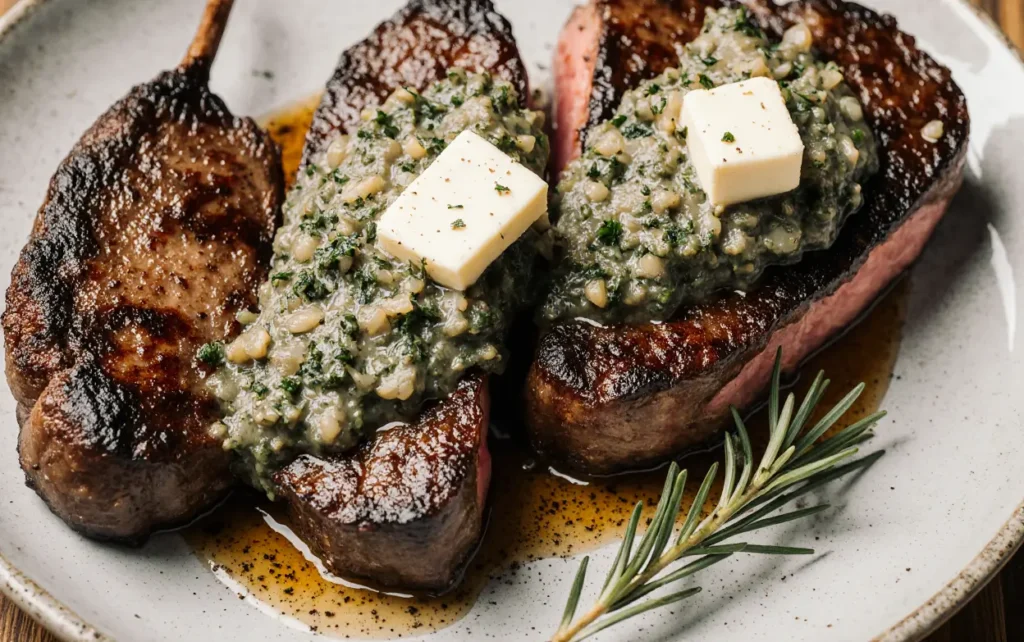
Storing Tips for the Recipe
Maximize freshness and flavor with these professional storage strategies:
Refrigerating Cooked Steak: Allow the steak to cool to room temperature (no more than 2 hours after cooking per food safety guidelines), then wrap tightly in aluminum foil or transfer to an airtight container. Properly stored, cooked steak remains fresh for 3-4 days in the refrigerator. Place the steak in the coldest part of your refrigerator (typically the back of the bottom shelf) where temperatures are most consistent at 35-38°F.
Freezing for Extended Storage: For longer storage, wrap individual portions tightly in plastic wrap, then in aluminum foil, and finally place in a freezer-safe bag with all air removed. This triple-layer protection prevents freezer burn. Properly frozen steak maintains quality for up to 3 months. Label with the date and contents for easy identification.
Storing Garlic Butter: The compound butter stores exceptionally well. Roll it into a log using parchment paper, twist the ends like a candy wrapper, and refrigerate for up to 2 weeks or freeze for up to 6 months. Slice off medallions as needed—this makes it incredibly convenient for quick weeknight meals. The garlic butter can transform simple chicken breasts, fish fillets, or vegetables into restaurant-quality dishes in minutes.
Reheating Without Drying: The biggest challenge with leftover steak is maintaining moisture during reheating. The best method involves bringing the steak to room temperature first, then reheating in a 250°F oven for 15-20 minutes until warmed through. Add a pat of garlic butter on top and tent with foil to trap steam. Alternatively, slice the steak thinly and quickly sear in a hot pan with additional butter for 30-60 seconds per side—this refreshes the exterior while minimizing interior overcooking.
Meal Prep Strategy: For meal prepping, cook the steaks to just below your desired doneness since they’ll continue cooking slightly during storage and reheating. Divide into individual portions with ½ tablespoon of garlic butter per serving before refrigerating. This pre-portioning saves time and ensures you don’t repeatedly expose the entire batch to temperature fluctuations.
Raw Meat Storage: If preparing components ahead, season the raw steak and store it in the refrigerator for up to 24 hours before cooking. This dry-brining process enhances flavor penetration and can improve tenderness by up to 15%. Keep the seasoned meat on a wire rack over a plate to allow air circulation, which further promotes surface drying for better searing.
Conclusion
This garlic butter Brazilian steak recipe proves that restaurant-quality results are absolutely achievable in your home kitchen. By understanding the science behind proper searing, temperature control, and flavor development, you can consistently produce steaks that rival—and often exceed—those found in expensive Brazilian steakhouses. The combination of perfectly seasoned, beautifully seared beef with aromatic, herb-infused garlic butter creates layers of flavor that satisfy on every level.
The versatility of this recipe makes it suitable for countless occasions, from intimate date nights to family gatherings and meal prep sessions. With a total time investment of just 35-40 minutes and readily available ingredients, you have no excuse not to master this impressive dish. The technique you’ll develop translates seamlessly to other proteins and cooking methods, making you a more confident and skilled home cook overall.
Whether you’re a seasoned home chef or a cooking novice, this recipe provides a framework for success through detailed instructions, helpful tips, and scientific insights that demystify the cooking process. The rich, buttery, garlicky flavors combined with perfectly cooked, tender beef create a meal that generates compliments every single time.
Don’t let another week pass without treating yourself to this exceptional dish. Gather your ingredients, heat up your pan, and experience the magic of Brazilian steakhouse cooking in your own home. Once you’ve perfected this recipe, come back and share your results—did you try any of the suggested variations? What sides did you serve? Your fellow food enthusiasts would love to hear about your experience in the comments below!
FAQs
Q: Can I use this garlic butter on other types of meat or protein?
A: Absolutely! This versatile garlic butter enhances virtually any protein. It works exceptionally well with chicken breasts, pork chops, lamb chops, salmon, shrimp, and even firm white fish like halibut. The butter is also fantastic melted over grilled vegetables, tossed with pasta, or spread on crusty bread. The preparation method remains the same—just adjust cooking times based on the specific protein and thickness.
Q: What’s the difference between picanha and other steak cuts?
A: Picanha, also called the sirloin cap or rump cap, is the most prized cut in Brazilian churrascarias. It comes from the top of the sirloin and features a thick fat cap on one side that bastes the meat as it cooks, creating exceptional flavor and tenderness. While similar in texture to sirloin, picanha has more marbling and a distinctive triangular shape. If unavailable, top sirloin or ribeye make excellent substitutes, though they’ll have slightly different fat distribution and flavor profiles.
Q: My garlic always burns before my steak is done. What am I doing wrong?
A: This is one of the most common issues. The solution is timing—never add the garlic butter until the final 2 minutes of cooking. Garlic begins to burn at temperatures above 375°F, which is well below the optimal searing temperature for steak. By adding it at the end, you get all the aromatic flavor without the bitter, burnt taste. If your butter is still browning too quickly, briefly remove the pan from heat and let it cool slightly before continuing to baste.
Q: How can I tell when my steak is done without cutting into it?
A: The most accurate method is using an instant-read meat thermometer inserted into the thickest part of the steak. However, you can also use the finger-test method: touch your thumb to your index finger and feel the flesh below your thumb—this approximates the firmness of rare meat. Progress through each finger for medium-rare (middle finger), medium (ring finger), and well-done (pinky finger). With practice, this tactile method becomes remarkably accurate, though a thermometer remains the gold standard for consistency.
Q: Can I make this recipe on a regular grill instead of in a pan?
A: Yes! Grilling works beautifully for Brazilian steak and adds a smoky dimension that many prefer. Preheat your grill to high heat (450-500°F) and follow the same timing guidelines. The only modification: place a small cast-iron skillet or aluminum pan on the grill grates during the final 2 minutes, melt the garlic butter in it, and baste the steak while it’s still on the grill. This preserves the butter’s integrity and prevents it from dripping through the grates and causing flare-ups.
Q: Is it necessary to bring the steak to room temperature, or is that just a cooking myth?
A: This is actually science-backed and not a myth. A room-temperature steak cooks approximately 30% more evenly than one straight from the refrigerator. Cold steak requires more time to reach the desired internal temperature, which means the exterior can overcook while waiting for the interior to heat up. The 30-45 minute resting period significantly improves consistency and reduces the risk of an overcooked exterior with a raw center. For food safety, never leave meat at room temperature for more than 2 hours.
Q: Can I prepare the garlic butter in advance?
A: Definitely! The garlic butter actually improves with time as the flavors meld together. Prepare it up to 3 days in advance and store it covered in the refrigerator, or freeze for up to 6 months. For an elegant presentation, roll it into a log using parchment paper, refrigerate until firm, then slice into medallions. These butter rounds can be placed directly on hot steaks for an impressive, restaurant-style finish. Many professional chefs keep flavored compound butters on hand specifically for this convenience.

